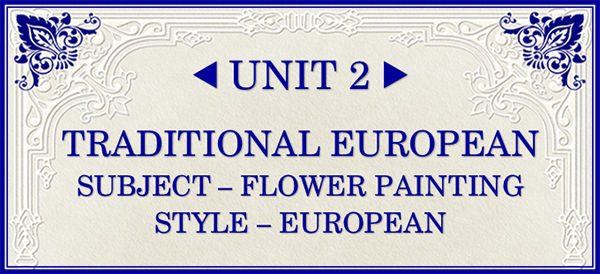
Click HERE to return to the Unit Judging Guidelines page for more details on each unit
or click the quick link button below to go the Unit

✽ UNIT 2 ✽
Research needs to be done on this Unit and it is an interesting subject for Porcelain painters and the basis of good painting techniques. Different styles for this category could be - Nyon, Dresden, Sevres, Berlin, Meissen and others.
This Unit must be painted on a glazed porcelain plate, tile or other suitable porcelain shape at least 6inches or 15cm.
Tiles must be suitably framed, but must NOT be under glass.
● NO Ceramics
● NO Porcelain Canvas
● NO Porcelain Bisque
● Bone China is acceptable
● NO Monochrome
● NO Lustre
● NO Metallics
● NO Pre-Grounding
● NO Dusting
JUDGING: Traditional European Style - Research this Unit. Read General Judging Guidelines and Judging Guidelines, etc. on Pages 2 - 6 of the "Porcelain Art Teachers New Zealand Judging Guidelines" booklet or here on our site.
European Porcelain factories employed artists who moved from factory to factory learning new techniques and leaving behind some of their own style. So being hard and fast about which style originated in any particular factory is difficult. However, several basic rules apply.
TECHNIQUE/APPLICATION:
This style depends on good crisp clean brushstrokes. Use of the brush to give character to a petal or leaf is important. Scratchy, patchy brushstrokes have no place in this Unit.
DESIGN/SUITABILITY:
Many of the more ornate pieces of porcelain may be used in this Unit for traditionally they were frequently used. However, plain porcelain is also acceptable and can be ornamented suitably. (Read the rules about decorative effect in General Guidelines.)
Traditional flower painting may have one group of flowers or smaller scattered flowers, or a combination of both. Flowers have some slightly exaggerated features and are partly stylised.
COLOUR/VALUE:
Look for fresh colours - European painters rarely used muddy colours. A distinct light value/dark value can be seen in flower painting and NO European style flowers have the same value all over - no matter how small. Floral work often features the use of all three primary and secondary colours.
